I had the opportunity to be in a classroom yesterday and watch as a first-year teacher created a safe environment for students to share their thoughts. As the students entered the room she asked them to go to Nearpod.com on their laptops or to use the app that she had told them they could download on their phone. She posted a code for them to join her session. She asked that they all join by using the name that she has for them in her grade book. (Good practice for teachers always.)
The students had not used this tool before and were curious if everyone would be able to see their name and what they wrote. The teacher explained that she would be able to see who had submitted the response but that the class would not be able to see. Once the students had all entered the session she posted a discussion question she phrased as a journal entry. She set a timer put on some music and had each student respond to the prompt. The class of about 30 juniors got very quiet. The prompt that the students were responding to was "What does love mean to you?" Give examples, 5 sentence minimum. The question posted in the prompt is a question that most juniors in high school have an answer to but sharing those thoughts in front of peers is not something some students feel comfortable doing. Using Nearpod, the teacher was able to quickly see who had submitted responses and encourage those that had not submitted yet to finish their thoughts. When the timer went off the discussion began.
The teacher began by recapping some characters involvement with each other in A Rose for Emily. She then began to share some of the responses that students had submitted and this is where the teacher used student voice to help her students make the connection between the content and reality. The discussion made the book relevant and personal to the class hence creating meaningful learning for the students in the class. The use of Nearpod as a response tool made the class flow efficiently and created an avenue where students felt safe sharing their thoughts.
At the close of the discussion, the teacher advanced her Nearpod lesson and the students completed a formative assessment measuring vocabulary mastery. Great lesson, good connection of content to real life for students and nice use of a formative assessment tool.






 RSS Feed
RSS Feed
